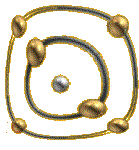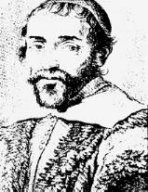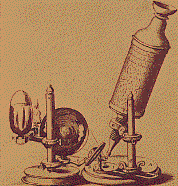AwayMave Home Page | IEPPP Home Page | 406 Module Home Page | University Home Page | VP Home Page

AwayMave Home Page | IEPPP Home Page | 406 Module Home Page | University Home Page | VP Home Page |
||
 |
||
Reason, nature and the human being in the West: Part 2 |
||
2.1The Mechanical Philosophy |
Summary The mechanical philosophy
|
| Machiavelli | 1469 - 1527 | |
| Bacon | c1561 - 1626 | |
| Galileo | 1564 - 1642 | |
| Hobbes | 1588 - 1679 | |
| Descartes | 1596 - 1650 | |
| Boyle | 1627 - 1691 | |
| Locke | 1632 - 1704 | |
| Newton | 1642 - 1727 | |
| Leibniz | 1646 - 1716 | |
| Berkeley | 1685 - 1753 | |
| Hume | 1711 - 1776 | |
| Kant | 1724 - 1804 |
By the end of the 17th Century it was very generally agreed that the universe was entirely made up of small solid corpuscles which moved and changed direction as they bumped and were bumped . There was, in other words, a consensus in favour of the mechanical philosophy, and the material atom.
 |
Leibniz and the mechanical philosophy |
(This consensus however was not quite common ground. Leibniz' voice in particular was a counterpoint to the consensual plainsong.)
 |
| Gassendi |
The mechanical philosophy was foreshadowed in Galileo and Kepler, then articulated in mature form by Mersenne, Gassendi and Hobbes: and, pre-eminently, by Descartes (1596-1650).
| |
Renaissance Naturalism |
Atomism is the view that the physical universe is made up entirely of "extended, continuous, homogeneous little lumps, which are intrinsically indivisible" (C.D. Broad, Leibniz (Cambridge 1975) p. 73).
Descartes himself was not a corpuscularian: he held that the universe was a plenum, and that matter was indefinitely divisible. For most purposes however it could be thought of as made up of particles - portions of the plenum operating, as it were, together.
A rival form of 'the mechanical philosophy' was articulated by - reintroduced from ancient thought by - Gassendi, and this might be thought of as corpuscularianism proper.
Corpuscularianism was associated by its leading proponents with the idea that some of the properties that objects appear to have are artifacts of the perceiving mind: 'secondary' qualities as distinguished from 'primary' qualities.
This seems to carry the implication that the universe as it really is, independent of being perceived, is less wonderful than it can sometimes seem.
It would make the world out to be, in itself, a severe and forbidding construction: just atoms moving about, with nothing but size, shape, solidity and motion. Most of the things which give human beings pleasure would not be there in reality, but somehow constructed by human beings themselves: colours, smells, sounds, tastes.
Primary and secondary qualities |
Descartes' dualism excluded 'any and all of the psychic characteristics' which earlier frameworks (eg 'Renaissance naturalism', but also, on some construals, Scholasticism, and medieval Aristotelian physics) had attributed to 'material nature'.
| |
R.S Westfall: The Construction of Modern Science, CUP edition, Cambridge, 1977, CUP |
Physical nature, for Descartes, is 'inert and devoid of sources of activity of its own.' (Richard S. Westfall: Science and Religion in Seventeenth-Century England, p.31.)
And Descartes' influence was decisive
'the rigid exclusion of the psychic from physical nature has remained [the 17th Century's] permanent legacy.' (Westfall, ibid, p.41.)
Part of the importance of 'excluding the psychic from physical nature' was the denial that matter on its own had any power to originate change.
'The mechanical philosophy insisted that all the phenomena of nature are produced by particles of matter in motion...' (Westfall: ibid, p.33.)
Physical nature, for Descartes, is 'inert and devoid of sources of activity of its own.' (Ibid, p. 31)
 |
| Richard Westfall has mounted an absorbing and greatly valuable set of biographies of early figures in the scientific revolution, as part of the Galileo project at Rice University. Pointers to all kinds of web material on the Scientific Revolution is provided by Fordham. Following this link will open a new window. Close it to come back here. |
For the leading proponents of mechanism everything was to be explained in terms of the 'two catholic principles', matter and motion. You could invoke the shape of a particle and its motion: but that is all. The idea that matter had any kind of active principle attaching to it, which had been at the core not only of Renaissance Naturalism but of the Scholastic framework too, was eliminated:
'In Renaissance Naturalism, mind and matter, spirit and body were not considered as separate entities; the ultimate reality in every body was its active principle, which partook at least to some extent of the characteristics of mind and spirit. The Aristotelian principle of 'form' had played an analogous role in a more subtle philosophy of nature. The effect of Cartesian dualism, in contrast, was to excise every trace of the psychic from material nature with surgical precision, leaving it a lifeless field knowing only the brute blows of inert chunks of matter.' (Westfall, ibid, p.31)
The received view was that the origin of motion was God: 'He created matter and set it in motion.' Once started, the movement was shuffled round but did not diminish. (Descartes propounded an explicit principle of conservation of quantity of motion.)
Descartes' view of animals as mechanisms
It is often argued that the early days of the new order the 17th Century showed great success in applying the mechanical perspective in physics and astronomy but rather little as far as animals and plants were concerned. The one real triumph with those was in fact the discovery of the circulation of the blood, which is therefore something you might like to look at in more detail.
Looking at the plant as a mechanical structure also led to the identification of the vessels which convey fluids up the stems of (some) plants.
 |
| Hooke's microscope, courtesy Berkeley University. Introduction to Hooke courtesy Berkeley University |
in 'Micrographica' (1665)
used the word "cell" in this connection, and on that account is regarded as the discoverer of same: it is clear though that he meant something like a tube, not a box. Looking through the microscope at a piece of cork he identified what seem, he said,
"to be the channels or pipes through which the Succus nutritius, or natural juices of vegetables are convey'd and seem to correspond to the veins, arteries, and other vessels in sensible creatures." (See Allen G. Debus, Man and Nature in the Renaissance. Cambridge, 1978, CUP, p.96.)
Of course: "Progress" made in the 17th C in the biological sphere was in relation to those elements of the organic frame that were susceptible to thinking of it as a mechanical device. Eg the circulation of the blood, the identification of the cell as a "structural" element.
Revised 04:05:04
IEPPP 406 Part 2 Home Page
IEPPP 406 Home Page
Reason, Nature and the Human Being in the West
Part of a module of the MA
in Values and the Environment Lancaster University
Send Mail to the Philosophy
Department